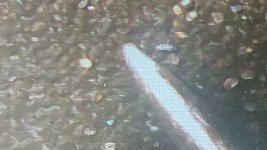bought some 150 mesh screen from amazon, this piece of gold went through that screen, tip of a safety pin for scale.
white light through a yellow paper reduces the glare (from the white light) on the gold.
this is using a microscope i bought on amazon, has a nice view screen so i am not looking through the lens to see the gold.
this is without the yellow paper filtering the white light .
.
white light through a yellow paper reduces the glare (from the white light) on the gold.

this is using a microscope i bought on amazon, has a nice view screen so i am not looking through the lens to see the gold.
this is without the yellow paper filtering the white light
 .
.Amazon Forum Fav 👍
Upvote
5





